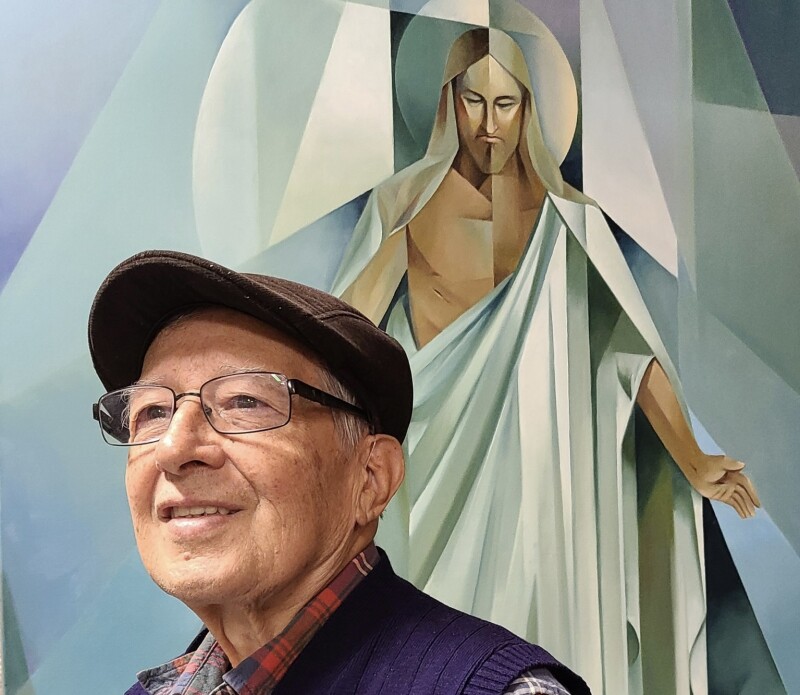Beloved Latter-day Saint artist Jorge Cocco Santangelo says he has known his entire life that he was meant to be an artist. But prior to joining The Church of Jesus Christ of Latter-day Saints in 1962, he painted landscapes and still life art. Upon joining the Church, he painted a portrait of Jesus Christ to hang on the wall in the very humble apartment building where he and his fellow Latter-day Saints met in Argentina. Jorge is now 86 years old and he is still painting pieces of religious art. The responsibility that rests with a religious painter is not something that he takes lightly. Instead, he calls painting Jesus Christ “the highest degree of commitment,” but why? Why do these paintings carry with them a greater meaning and significance?
The artist shares some of his thoughts in the excerpt below. You can listen to the full interview in the player below or by clicking here. You can also read a full transcript by clicking here.
The following excerpt has been edited for clarity.
Morgan Jones Pearson: You said the very first painting that you painted [of a religious nature] was a painting of Jesus Christ. You called painting Jesus Christ the highest degree of commitment and said that it is the heaviest burden for an artist. I wondered, what is your approach like Jorge, when you sit down to paint a painting of the Savior?
Jorge Cocco Santangelo: So you can paint any worldly painting be it a landscape, a master painting, or still life, and you can apply all the resources and the laws of art, you can transmit all the harmony and all the possible beauty. But to paint Jesus Christ is to walk into sacred ground. And to be able to do that you have to transport yourself into a spiritual realm, in which you have to be yourself in a spiritual state of mind. Because you’re not painting a human being, you’re painting a God, and you need a concept, and that never arrives.
Morgan Jones Pearson: Well said. So I noticed in one of the articles that I read about you, you said that you couldn’t portray Jesus Christ correctly if you did not have a testimony of Him. You just mentioned that you are not painting a person, you’re painting a God. … So why is it important for you to prepare spiritually for these paintings and make sure that you’re in the right spirit to be able to paint them?
Jorge Cocco Santangelo: Because otherwise, I will be painting something historic. So Jesus Christ taught things that are able to be told, but the content is spiritual. And the challenge is to make a painting that you can see, but the content of it needs to be spiritual. And if you don’t have a testimony by the Spirit, you cannot paint something of that nature, the spiritual nature.
Morgan Jones Pearson: So, Jorge, you approach these art pieces a bit differently than most Latter-day Saint artists. So, you call this approach sacrocubism. Amiel, maybe before we even have your dad comment on this, you can explain to us what sacrocubism is.
Amiel Cocco: Sure, so I basically coined the word because cubism is an art movement that is associated with Picasso and Braque, it was called like that because they use a lot of cubes and geometric shapes. But cubism had to do with the objectification of people. And so there was room there for using the same approach, the same artistic language, but with a different end, which was to make things spiritual. So the opposite, that’s why it was used. And so that’s why we call it “sacro,” which means sacred in Latin. So that’s why there was a room there to make a distinction and to call it a little bit different—sacrocubism.
Morgan Jones Pearson: Okay, that makes sense. Okay, so, Jorge, you’ve said that you use colors and forms that convey a spiritual message because a color and a shape can produce an impact that is superior to the visual and can teach our spirits similar to what we find in music. How would you say that this unique art style is able to communicate even more sometimes than the classical style that we usually see in church art?
Jorge Cocco Santangelo: I am capable of painting a person just the way the eye sees it. And when that happens the focus of the person observing the art is called to notice the artist’s technique. And so they comment, if it is a good painting, then they would say, “Oh, how wonderful it looks like a real person. It looks like the person is alive. It looks like we can touch that person.” But that is not the objective of art according to my philosophy. You can reach that point with technique but to me, art needs to take the person out of the material and physical reality of everyday life and elevate to the transcendent events, to things that you can find behind or beyond that painted scene. So I try to avoid it as much as possible, any reference to the actual looks of the person and the landscape so that the form and color may produce a new feeling, a new sensation because we’re not trying to imitate—to replicate–the physical reality. When we see a person that speaks by the Spirit, it doesn’t matter the way they’re dressed. It doesn’t matter what they look like. The important thing is that their Spirit touched our spirit and when a form and a color touches our spirit, then art made its magic.
► You may also like: Meet Jorge Cocco, a Latter-day Saint convert who paints in a “Sacrocubist” style

